By Leocthasme
A couple of months ago I wrote an article on US Railroads and Steam Locomotives, and since it sort of brought a bit of attention to my various ramblings, I thought I might add more information about Railroad Lore. A good place to start is with the KATY since my father worked for this line not long after he returned home from WW1. He started with them in Pittsburg Kansas and ended up in Saint Louis at their freight rate offices. Other members of my father’s family also worked for the Railroads, but those are other stories I will attempt to expound on at a later date as I pick up on all the rail history in my family. My dad’s father and a brother also worked for various rail industries, and it seems my granddad at one time or another related stories to me about earlier Helmer family ancestors having some history with railroads, some are even repeatable.
The Missouri-Kansas-Texas Railroad,
The Katy
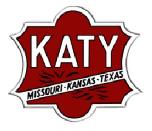 |
The Katy logo-Click for larger view
The Missouri-Kansas-Texas Railroad, better known as simply The Katy or K-T, was a large granger system that, like the Illinois Central and Gulf, Mobile & Ohio Railroads ran, unconventionally, north-south (instead of the more common, east-west).
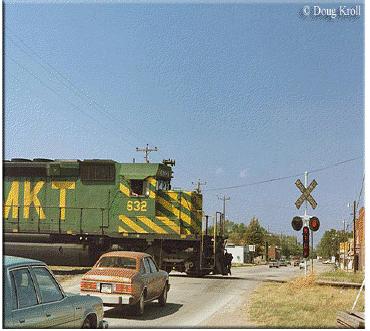 | As its name implies, the Katy connected all of its namesake states |
with connections to cities such as Omaha and St. Louis in the north and Galveston and San Antonio, Texas in the south.
The railroad was somewhat successful over the years but it ran into financial trouble a number of times throughout its life. As finances again became an issue in the 1980s the MKT sought a merger with the Union Pacific Railroad in 1986 and in 1989 the Katy became yet another part of the UP empire.
The Katy has its beginnings dating back to 1865 when the Union Pacific Railway (later changed to the Missouri Kansas and Texas Railroad in 1870) was chartered to build a line connecting Junction City, Kansas to New Orleans. Around the same time the railroad was able to reach Texas, Oklahoma, and Missouri when it took control of the Tebo & Neosho Railroad which connected places like Sedalia and Clinton, Missouri with Nevada, Missouri.
Of note the Katy was leased to the Missouri Pacific in 1880 and became part of the burgeoning Jay Gould empire for a time, which lasted until 1888. The biggest advantage the Katy gained from this leasing was that it acquired new markets and reached cities like Fort Worth, Dallas, and Waco, Texas.
 |
While profits and the overall health of Katy ebbed and flowed through its early years, after the lucrative World War II traffic ended following 1945 it became increasingly difficult to remain solvent.
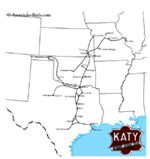 |
The Katy, of course, never had the most direct lines and in a region choked with other railroads it comes as no surprise that trying to survive became an increasingly tricky task as the years progressed (to add to its problems the railroad had poor management on and off throughout its existence).
The Missouri-Kansas-Texas Railroad also never had an extensive passenger network (which, looking back at history today this wasn’t necessarily a bad thing, particularly as the service began to eat away severely at profits across the industry following WWII) and as early as the 1950s the railroad began to wholesale abandon unprofitable rail lines and shutdown passenger operations where possible.
By the 1970s things were looking better for the Katy as a new president, Reginald Whitman, worked to abandon unprofitable lines and passenger operations and bring in new freight business, which had become quite successful by the early 1980s. However, the merger movement of the 1980s was, unfortunately, the final blow for the Katy.
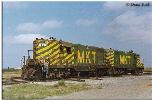 | Click for larger view--With the loss of profitable overhead traffic |
provided by such railroads as the Missouri Pacific Railroad and Frisco and now a David among Goliaths surrounding the MKT it simply had no choice but to find a merger partner somewhere, which it did in 1986 with the Union Pacific Railroad and finally in December, 1989 the Katy officially became part of the UP system.
While much of the original Katy system has since been either abandoned or railbanked some of its lines continue to carry on, including with the Union Pacific. Although now gone, the Union Pacific recently paid homage to several of its predecessors, including the Katy, by painting one of its new EMD SD70ACe locomotives into a version of the railroad’s famous red and black passenger livery complete with a version of its well known livery.
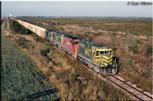 |
during September of 2005 and it received a number recognizing the Missouri-Kansas-Texas Railroad’s final year of independence, 1988.
Researched: January 2011 by Leo C. Helmer





No comments:
Post a Comment